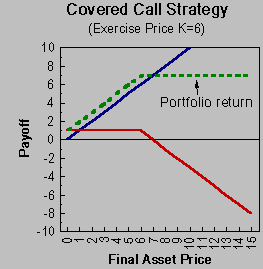Replicate call option payoff
You should describe exactly what trades are required over the two periods. To conduct this exercise, launch the Binomial Tree Module from the Virtual Classroom: On the Action part of the Window, select 2 from the drop down beside Steps and select Call from the drop down on the left side of the screen. This means that the time to maturity for this option equals the number of steps i.
The screen should appear as depicted below. Be careful to check beside Discrete Compounding as displayed below.

You can see all the nodes of the 2-period binomial tree. The stock price at this node is 50, as shown in the Action Window. When there is an uptick, the stock price moves to 75 1.
Section - replicating a call option - Actuarial Outpost
Next select Call Replication from the drop down as depicted below: Notice the tree depicts weights now. The top weight refers to the number of stocks and the bottom weight in each pair the number of bonds, required to replicate one call option.
By tracking how these numbers change we can formulate a trading strategy that creates a position that exactly mimics a call option.
To see why consider the following, initially by working backwards from the terminal nodes: Beginning of Period 2: Consider the top middle node above, long 0. The terminal payoff from this is either: The node below this is 0, 0 because irrespective of forexsystems.ru graal tick the call option finishes out of the money if this node is reached. Beginning of Period 1: From the Tree that depicts the Call option see below: Observe that at the beginning of period 1 the two possible end of period values for the call option are: As a result, again we need to identify the replicating portfolio of stocks and bonds that can mimic this payoff.

The call replication tree two screens above reveals that the weights are: To check this observe that: So by working backwards we forex charting software comparison identify the appropriate position weights that mimic the call option. But observe that these weights change from node to node. This implies that to implement this solution we can only work forward in time.
As a result, need to rebalance our position as we replicate call option payoff forward through the tree. That is, we replicate call option payoff only mimic the option values by a trading solution!
Now we need to keep track of the starting and ending portfolio weights so we can identify the appropriate trades. When you replicate an option by trading, you must trade stocks and bonds in at the first node to obtain the same values as the call at the two nodes in period 1.
The difference between the start and end position at a node is the net trade at the node. If you keep track of all the net trades, then as you work through the tree, you define what is called a trading strategy. Refer to the call replication tree depicted above. This contains position weights relative to 1 unit of the stock. Therefore, if you start period 1 with 0. To do this requires that you buy 0.
Put–call parity - Wikipedia
Similarly, if a down tick was realized you want to start period 2 with 0 stocks and 0 bonds. This implies that you will sell 0. To summarize, the trading strategy required to replicate the call is: If there is a downtick, sell 0.
Section - replicating a call option - Actuarial Outpost
In an up tick, buy an additional 0. The stock and bond portfolio will now track the call options payoffs. In the next lesson we will consider how we can exploit these trading principles to manage risk.